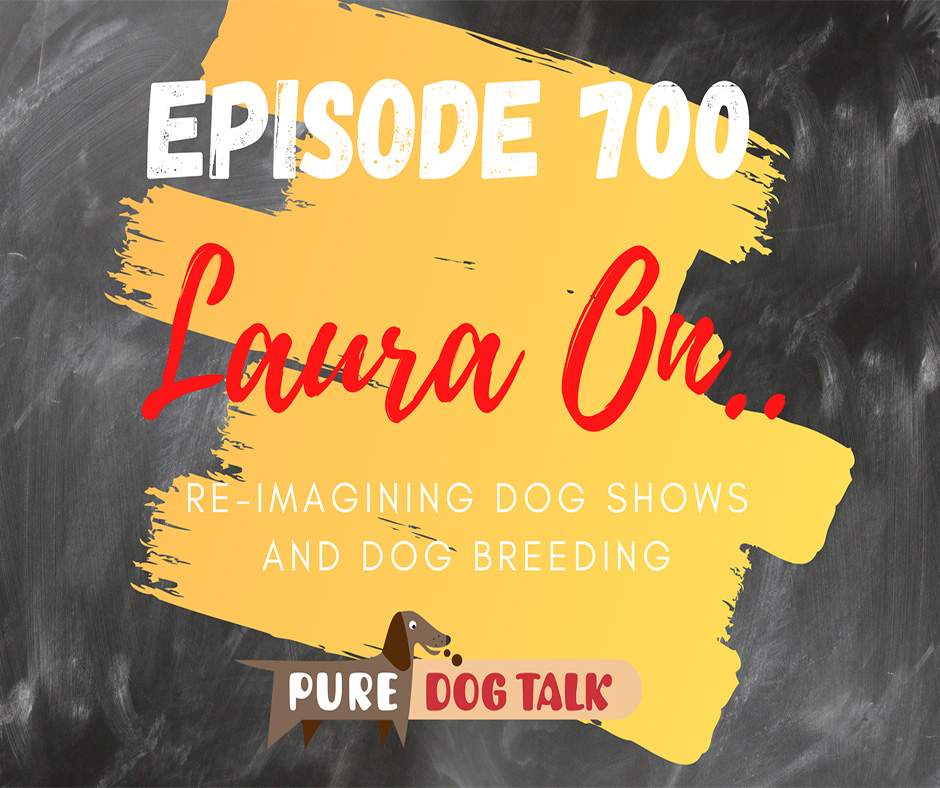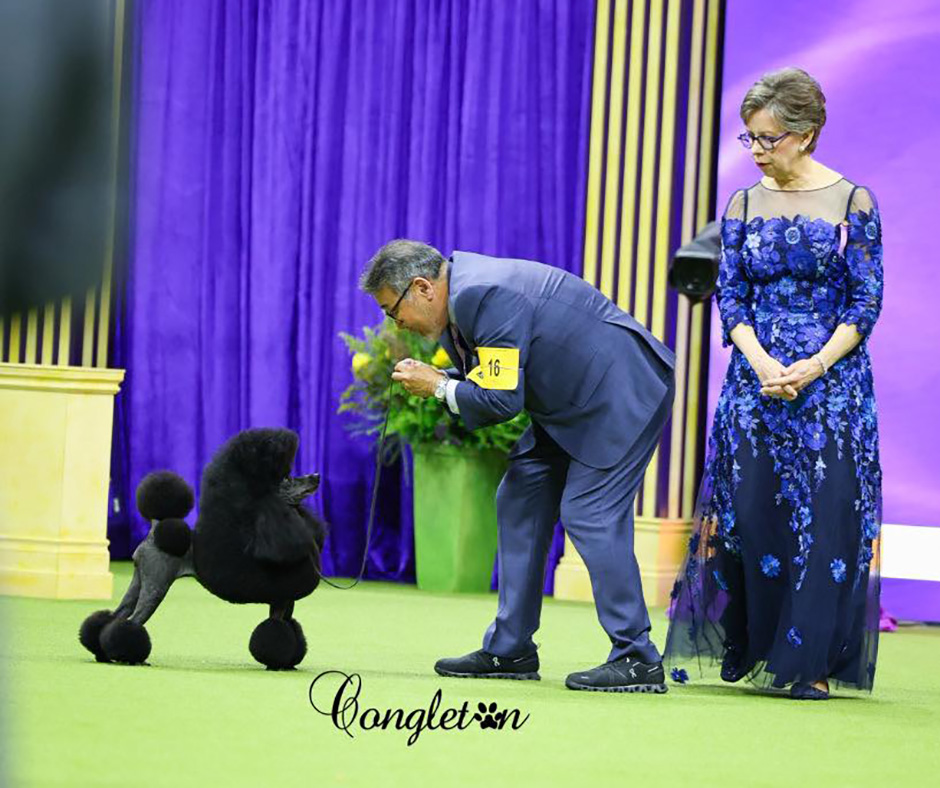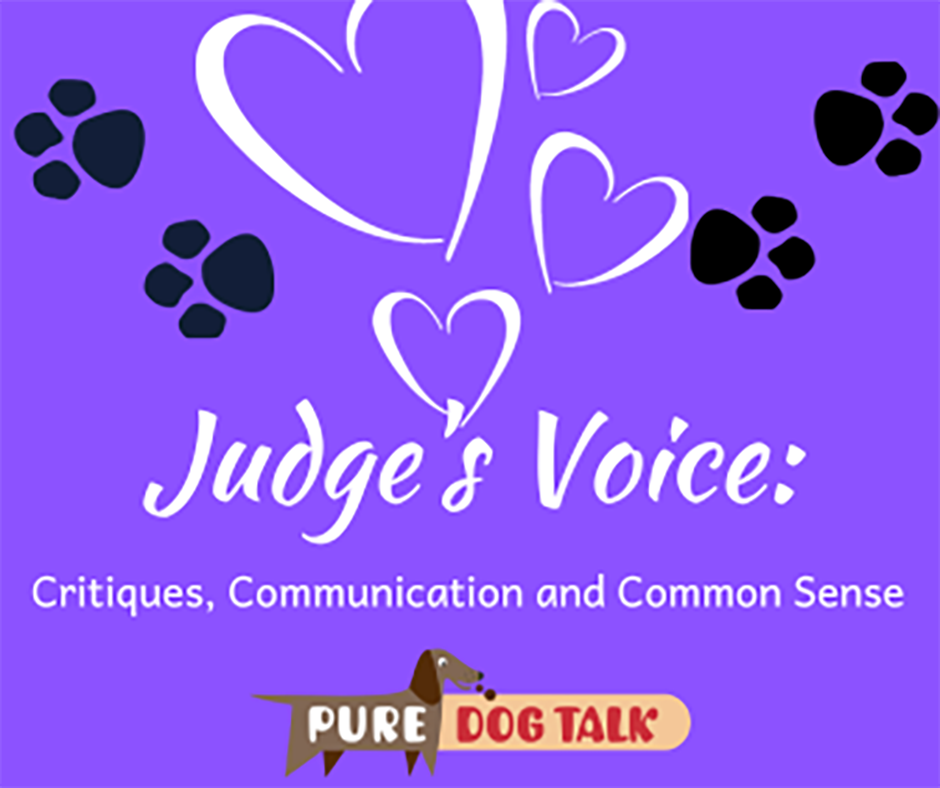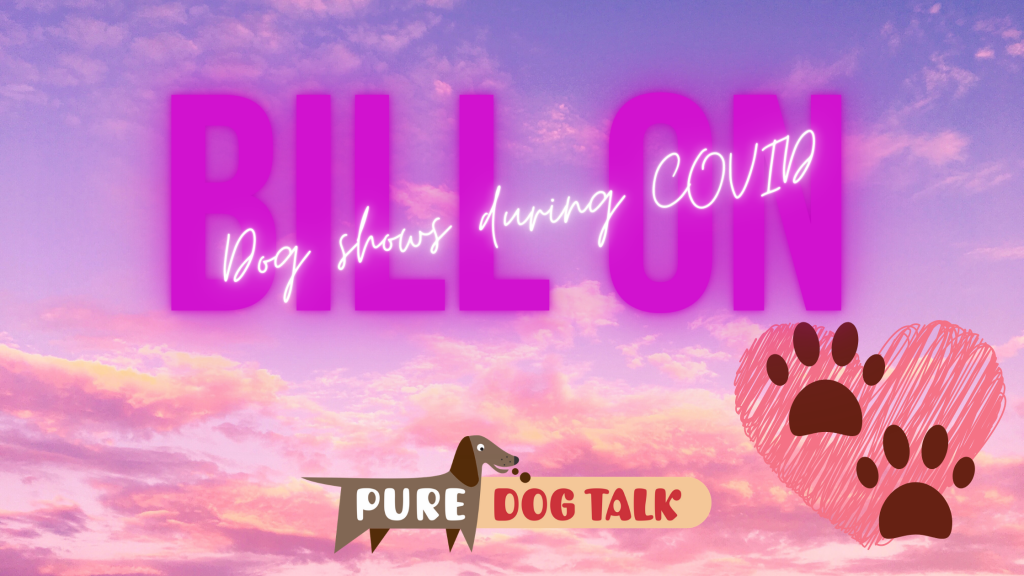700 — Laura On: Re-imagining Dog Shows and Dog Breeding
Episode 700: Re-imagining Dog Shows and Dog Breeding
It’s become a tradition here at Pure Dog Talk to celebrate the important milestones. Episode 700 feels surreal to me! Since November of 2016, NINE years, I’ve been hopping in the van with you guys for your road trips, joining you on the treadmill and the lawnmower, at the grooming table and discussions around the dinner table. Crazy talk!
But, here we are. This year we even kicked off a new adventure with the Marty and Laura Show, reaching out to the general public, your puppy buyers and your cousin’s uncle’s girlfriend with trusted, knowledgeable information on all things pet health.
We’ve also developed the Pedigrees to Pups Seminar series and are actively in process of making those available as courses on demand.
I’ve got a new audio book about to hit the shelves and a long list of really excellent conversations upcoming. So the future looks bright in podcastlandia.
I’m just a little concerned I’m going to be talking to myself here eventually. As I watch the sport of dog shows dwindle, litter registrations drop off and dog breeders retire, age out, drop out and give up, it gives me pause for our future.
I had a call recently from a long time judge who shared my concerns about the “future of the sport.” It’s not a new conversation. It’s been around for at least the last 25 years. And we’re still here chugging along. A little more spread thin with lots and lots and lots of small shows. A little greyer and gimpier. My friend discussed various initiatives from AKC that she thinks are to blame. But honestly I think it’s simple.
Dog shows are expensive. Breeding dogs is ridiculously expensive. And really hard. You get the tremendous highs but those heartbreaking lows are really hard to take. Those of us who have dedicated our lives to this can’t understand why people don’t want to abuse their bodies, emotions and wallets for the chance at creating that one big winner.
But a thing one of my guests said recently has really stuck with me. In his book Familiaris, David Wroblewski touches on a theme that I think we need to let roll around in our minds for a while.
His fictional dog breeder character describes the importance of creating something lasting and beautiful in the world. The idea of pursuing one impossible thing. That dog breeding is something like a “great quest” and gives our lives purpose.
So here’s my pitch.
We need MORE dog breeders, not fewer. But we need more GOOD dog breeders. People who put the dogs not the profit margin first. Not saying making money is a sin. It isn’t. But when you center the dogs, the breed and the buyers, you might not retire a billionaire, but you won’t go broke either. We’ve spent a good bit of time this year on providing content that helps people understand HOW to do this and do it well. That’s a big part of why we created the Pedigrees to Pups seminars. We had Matt Stelter on to talk about website and content creation. We talked to my friend BB who started a YouTube channel with his Brittany litter.
My challenge, dear listeners, is to extend your involvement. If you haven’t yet, consider working with your breeder to whelp and raise a litter under their guidance. Decide that ribbons get dusty, but building a strong family of dogs who will go on to bring joy to hundreds maybe even thousands of people over multiple decades is a vision worth having. It is a lifetime project that is WORTH your time, your effort, your investment, your blood, sweat and tears.
Because I promise you, when you start walking toward the end of your path, and you look back at your “body of work” with pride and love and the extended family of puppy buyers going back decades, it IS worthy of your effort.
Building something lasting doesn’t have to be a bridge out of concrete. It can be as real and as warm as the trusting gaze of an old friend looking out at you from the eyes of a new puppy.
We don’t have to buy the propaganda that PETA has sold us. We don’t have to hide our dogs and our passion. We don’t have to accept that the general public has zero concept of animal husbandry. WE can be the difference. We can use our voices to educate. If you aren’t comfortable speaking yourself, share resources like this one or the marty and laura show. AKC has resources. Our world is *drowning* in information that isn’t getting to the audience that needs to hear it. Preaching to the choir ain’t going to fix it y’all.
We don’t have to accept anti breeder legislation. WE can introduce ourselves as subject matter experts and be the ones the lawmakers call when in doubt. WE do have the power of our own destinies. Somehow, we have allowed those to be stolen from us by slick slogans and people who have never bred a litter of puppies in their lives telling us how to do what we do. And I don’t mean AKC. I mean YOU. Literally, you. Our numbers may not be legion, but our passion is.
It is long past time that we stand proud with that in our communities.
So, do a quick check on your heart. Are you showing that gorgeous bitch to her triple quintuple grand champion platinum? How about you breed her? Or at least support someone in the trenches who is doing the work and buy a new dog. And yes, you can find someone to sell you a good dog. I promise. If you’re struggling, email me. I’ll help.
We need you guys, All y’all, to hang with it. To dream. To plan. To get knocked down and *get back up again*! No matter what tragedy, what horror, what sadness or betrayal, it’s a safe bet you aren’t alone.
Surround yourself with positive people who find constructive ways to improve instead of finding other people to blame. Find your tribe. If you haven’t already, I invite you to join ours. The Pure Dog Talk Patrons community is deep and rich with support and knowledge and camaraderie. Stop by the website and click the Patrons tab to join us.
Everyone starts somewhere and certainly I’m no exception.
Nine years ago I didn’t know what a podcast even was. Mary kept pushing me to host this thing and I just was baffled. I googled and poked around and most of them were booooooring things about stuff I couldn’t understand.
Then I ran across a name I knew! Back in the Seattle days, I was running the Human Rights Watch Film Festival and one of our sponsors was The Stranger, a sort of alternative newspaper. The primary reason it was semi famous was one columnist, a dude I knew to wave at by the name of Dan Savage and his, mmm, quirky sex advice column called Savage Love. And there it was! The Savage Love podcast!
He had *500* episodes at the time and I figured I’d make it a goal to surpass that…. I’m past that now, but I haven’t quite managed to eclipse the kinky sex pod, so I guess we’ll just have to keep trying! And that’s kind of a circular way of making my point … Keep going, find a way to motivate yourself and keep going some more.
While you’re at it, help me beat Savage Love! Like, share, review and subscribe.
Talk ON. Peace….
661 – GRRRL Power Team Carries Forward Longo Great Dane Legacy
GRRRL Power Team Carries Forward Longo Great Dane Legacy
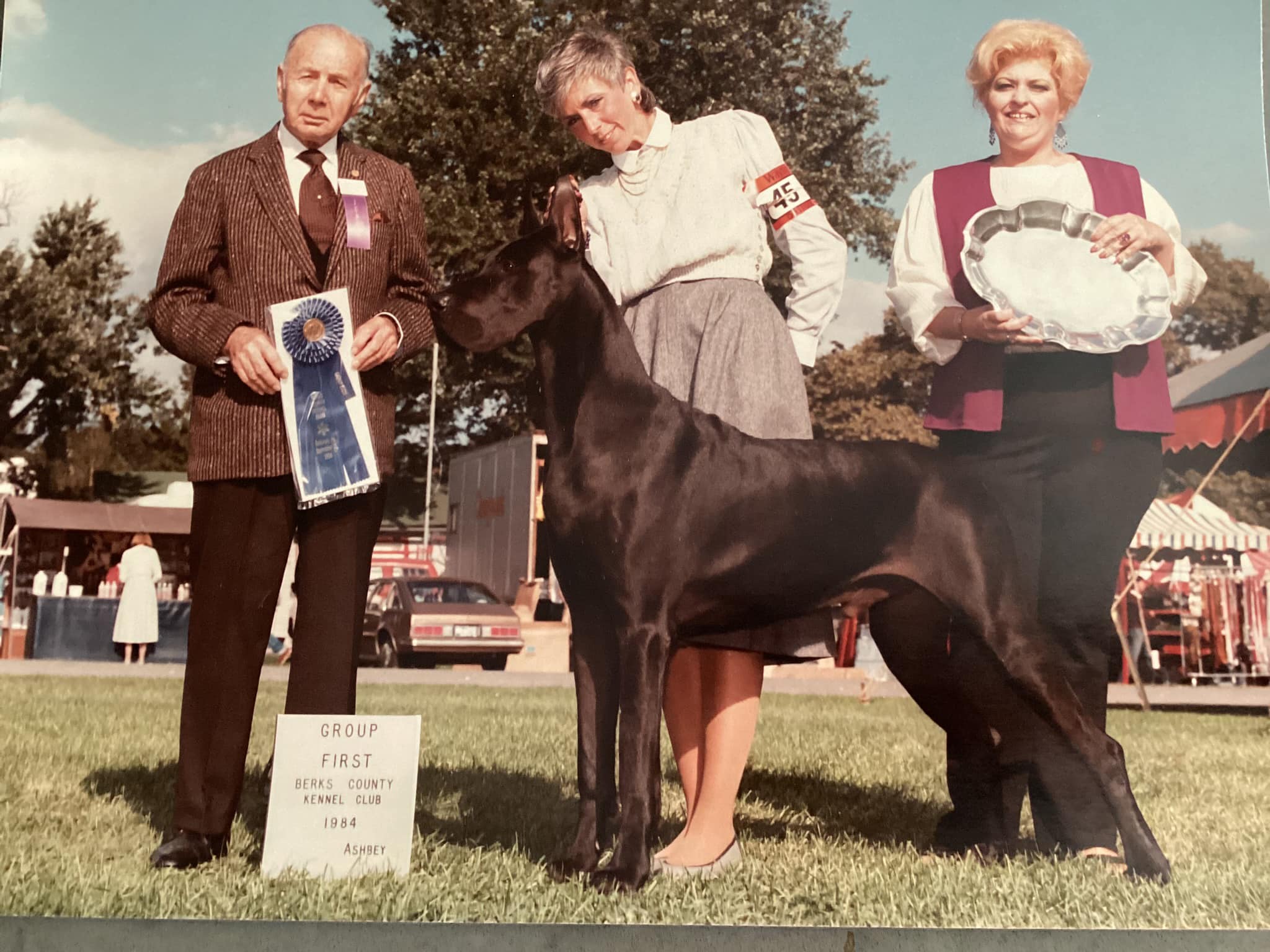
Carol Grossman became synonymous with black Great Danes and the Longo dogs.
Host Laura Reeves is joined by Carol Grossman, Jackie Van Delft and Tristen Lawrence with a tribute to Tootie Longo, who passed away in May of this year, and the Longo Great Dane legacy.
Grossman, the “Queen of Great Danes,” piloted dogs for Longo for decades, including legendary greats like the second Black in Breed history to win an All Breed Best In Show, BIS BISS Ch. Longo’s Chief Joseph. She shares her memory of Tootie Longo this way:
“As much of an icon as she was, she never really thought of herself as an icon, whereas Joey (Vergnetti) and Peter (Green) were icons. She didn’t realize they felt that way about her. That was Tootie. She just was not assertive about who she was. And she didn’t realize, I think, until the end, how famous she really was, that she carried a legacy of dogs through the years. She knew she had beautiful dogs and she knew she had a great line and she knew that she was lucky in picking dogs, but she never really realized what an icon she was.”
Van Delft is the more recent member of the group, a Great Dane enthusiast who had wanted a Dane since childhood. She sought out Tootie Longo to acquire a dog, and wound up as a “member of the family.”
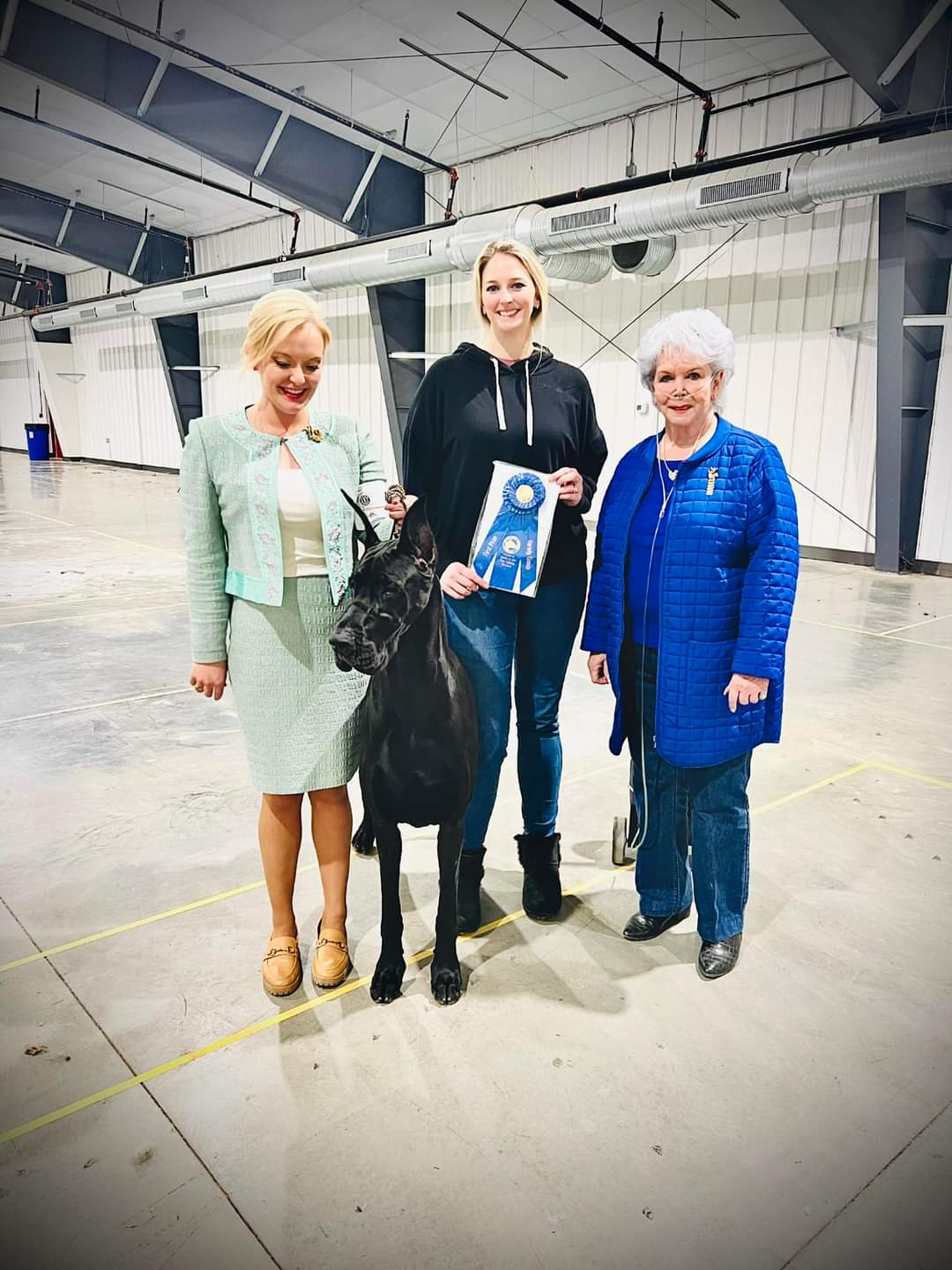
Jynx with (from left to right) Tristen Lawrence, Jackie Van Delft and Tootie Longo.
“Tootie pretty much took us under her wing,” Van Delft said. “We became really good friends… I got my first Longo puppy and he was amazing. He was my heart dog. But we would go to the Longos every weekend to twice a month. We were very lucky we only lived 45 minutes away from them. So we spent a lot of time and we got to go to all the shows together. And, you know, she just became a part of the family or I became part of hers, you know, and it’s just that was it. She wasn’t getting rid of me.”
Grossman and Van Delft were instrumental in selecting Lawrence, a third generation Great Dane exhibitor, to campaign Jynx, one of the last of Tootie’s dogs, to 36 specialty wins.
“I’m a Great Dane handler my whole life,” Lawrence said. “My parents and both of their parents on both sides were very active in the breed as breeders as well as handlers. So there’s never been a time that I didn’t do this. I remember Tootie Longo as long as I’ve been alive. And so growing up, knowing the power and what she built in our sport, it was incredible and for her to come to me and say ‘we want you to show our dog,’ I can’t describe how proud I was, how incredible that was to me.”
634 – Best Advice from Best in Show Judge, Roz Kramer
Best Advice from Best in Show Judge, Roz Kramer
Roz Kramer, Best in Show judge for Westminster Kennel Club last week, joins host Laura Reeves with advice, stories, suggestions and tips for all exhibitors.
On judging Best in Show at Westminster
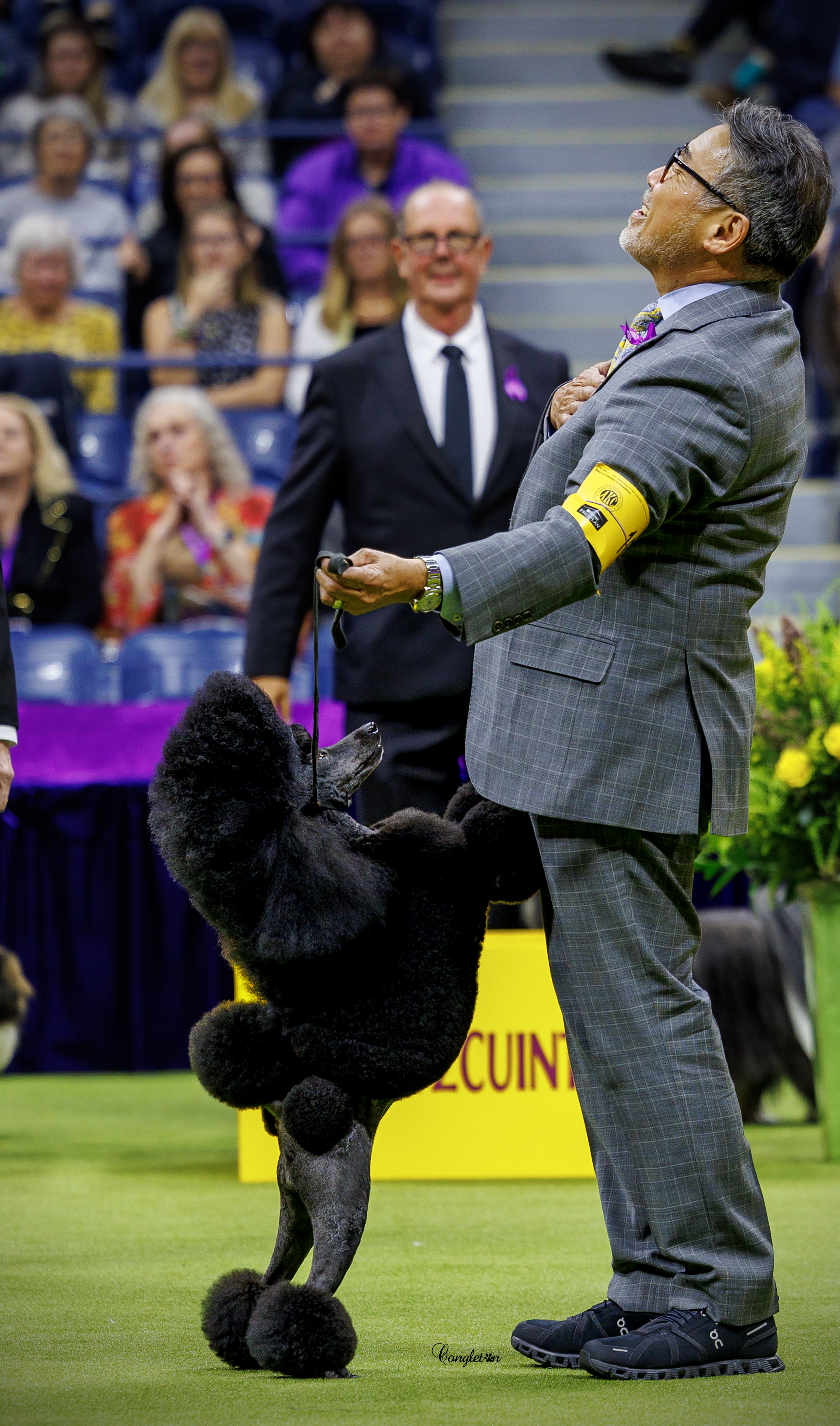
Kaz Hosaka, winning BIS at WKC with the Miniature Poodle, Sage.
“You know, you’re sequestered and so you don’t really know who you’re getting and they come in the ring one at a time and it was one gorgeous dog after another.
“I mean, all of them showed like a million bucks. They all looked wonderful, fabulous condition. And it gave me goosebumps. It really did. I was so happy and so thrilled.
On her mentors
“I have had three incredible mentors for me Annie (Rogers Clark), Janey and Bob (Forsyth). I had so much respect for the three of them. Annie, she was such a teacher in many ways. I never worked for any of them, but you saw them at shows all the time and they’d give you little hints or little suggestions all the time and or you’d just sit and listen to them and you’d learn.
On how newer exhibitors can succeed
“You should stick around (after showing in the ring), learn your history of your breed, learn who the greats of the breed were, learn your pedigrees, figure out who the best multiple breeders of your breed, and it wouldn’t matter if they’re ones on the west coast and ones in Texas and ones in Maine. Seek those people out, learn the best you can. And then if you get a dog, don’t be afraid to go, not just ask other breeders for help on trimming or showing.
“I’m telling you, you go to most of these handlers, it doesn’t matter who they are, they are more than willing to help. We need the new people in the sport and everybody knows it and I think that what people also need to do is don’t think that you’re better than everybody else, be kind and caring to people because you know something, we all have to ask for help at some point in our lives and don’t be afraid to.
“You know one of the ways that I learned when I was a kid is my mentor on the Scotty’s John Sheehan. He’d trim the show side and then he’d say ‘okay now you trim the other side. Copy that.’
“(There) is the conditioning part. And it was a teaching tool to me that you do this day after day, hour after hour, and don’t stop. And it’s going to pay off.
“It’s artistry, and I think people prefer the quick fix and the easy fix. I think that people should give themselves a challenge, prove what they can accomplish and they might be surprised.”
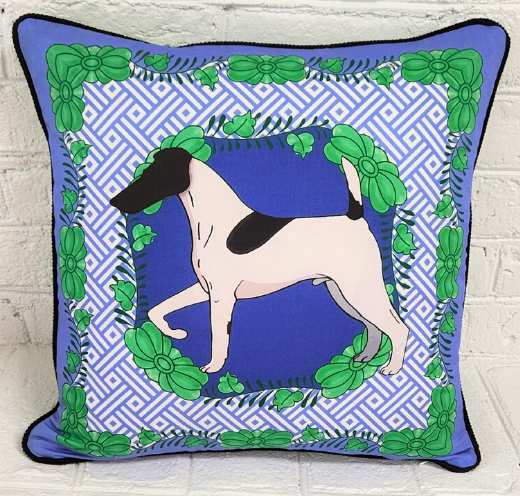
Kramer’s Etsy shop features home decor and fashion items like this pillow cover.
Visit Kramer’s Etsy shop to see her beautiful breed specific designs on home decor and fashion items.
609 – Critiques, Communication and Common Sense in Dog Shows
Critiques, Communication and Common Sense in Dog Shows

Steve Dainard judging Spinoni back in the day, when Laura was still showing dogs.
Canadian Kennel Club judge Steve Dainard is back with host Laura Reeves for part two of a probing and thoughtful conversation about critiques, communication and common sense in dog shows.
“So we know that every rule and regulation that came in probably had a foundation in someone doing something wrong,” Dainard notes. “Judges need to keep their interactions in the ring, not be too conversational in nature. Well, then all of a sudden you’re going to get a whole population of judges who take us to the nth degree, and they’re even afraid to have any type of communication, apart from instructions to the exhibitor.
“So, I think there’s a fine line between having this full on getting caught up in the ring, but also having, an opportunity to be able to share meaningful dialogue. And I think that we can do that. I think that maybe we’re just not trained really well to do that. So maybe we need to have a discussion about what does that look like.
“I get it, writing written critiques or an oral critique or whatever can be scary for many people. People don’t like change, and whether it’s not because you don’t have the goods or you don’t know whatever, maybe that’s what the fear is based in. But I think culturally, you just hit the nail on the head, it’s not encouraged to have that dialogue, that communication, that interaction. And what it does, it creates silos within our sport. And this is not what we need. We need to be able to have a mechanism in place so that it’s okay to have a conversation.
“And that conversation doesn’t need to be precipitated by the fact that I’m pissed off because Laura didn’t put me up and I’m going to take a run at her after judging. And I got the rep coming with me because she crossed a line.
“Having a written critique foundation in your toolkit as the basis for how you’re trained to evaluate dogs creates a much easier conversation when that’s the way you’re programmed and how you’re picking your winners.
“I think that the fear of error is like, (exhibitors are) judging me, right? So I can see why people would be afraid of that until you get really good at it. And you have the conviction to be able to say, this is my process. I think it could be a little bit of an overwhelming concept, but the only way we rip that bandaid off is by diving in and starting to practice it.”
Listen to the full episode for insights on the role of judges in promoting responsible dog breeding and ownership and much more.
605 – LIVE Debate: Should Professional Handlers Be Allowed in BPUP?
LIVE Debate: Should Professional Handlers Be Allowed in BPUP?
Our final installation for Spicy October is a LIVE@5 debate between an owner handler and a professional handler regarding the hot topic of the rules around the BPUP, 4-6 months puppy competition.
Natalie Thurman, owner handler:
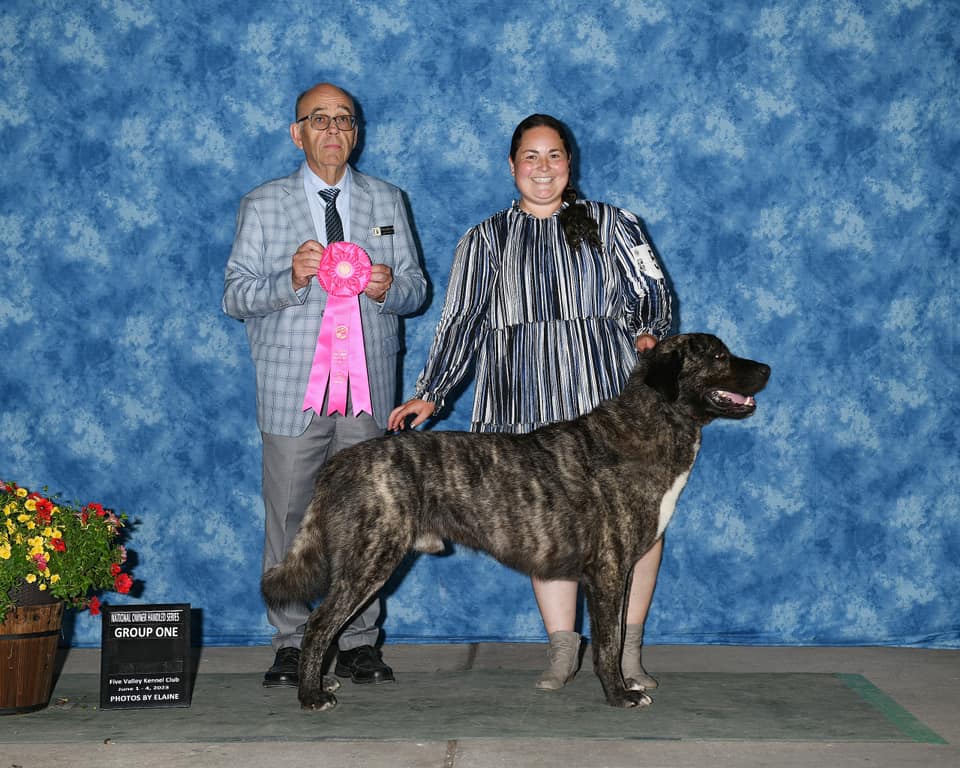
Natalie Thurman and Ares winning Owner Handled Group.
I do think that there are people who start out and it is intimidating to go up against the Laura’s and the Karyn’s of the world because you just make it look so easy and then we try to go do it and then it’s not as easy. Not even a little bit. I mean I know it’s why we have owner handled groups. But if you’re not getting to the owner handled group either BPUP could be a good place to feel safe as a non-experienced dog show human.
Karyn Cowdrey, professional handler:
I believe everyone should have the opportunity, including breeder owner handlers, to show in BPUP. Why? Because the fact of reality of our life today is there are fewer and fewer handling classes people can get to. As handlers, often we’re the ones teaching the handling class and we don’t get to work our dogs in the environment. As a handler, it is important to me that my puppies that I own, that I bred, that I decided to keep, get the best experience they can in the
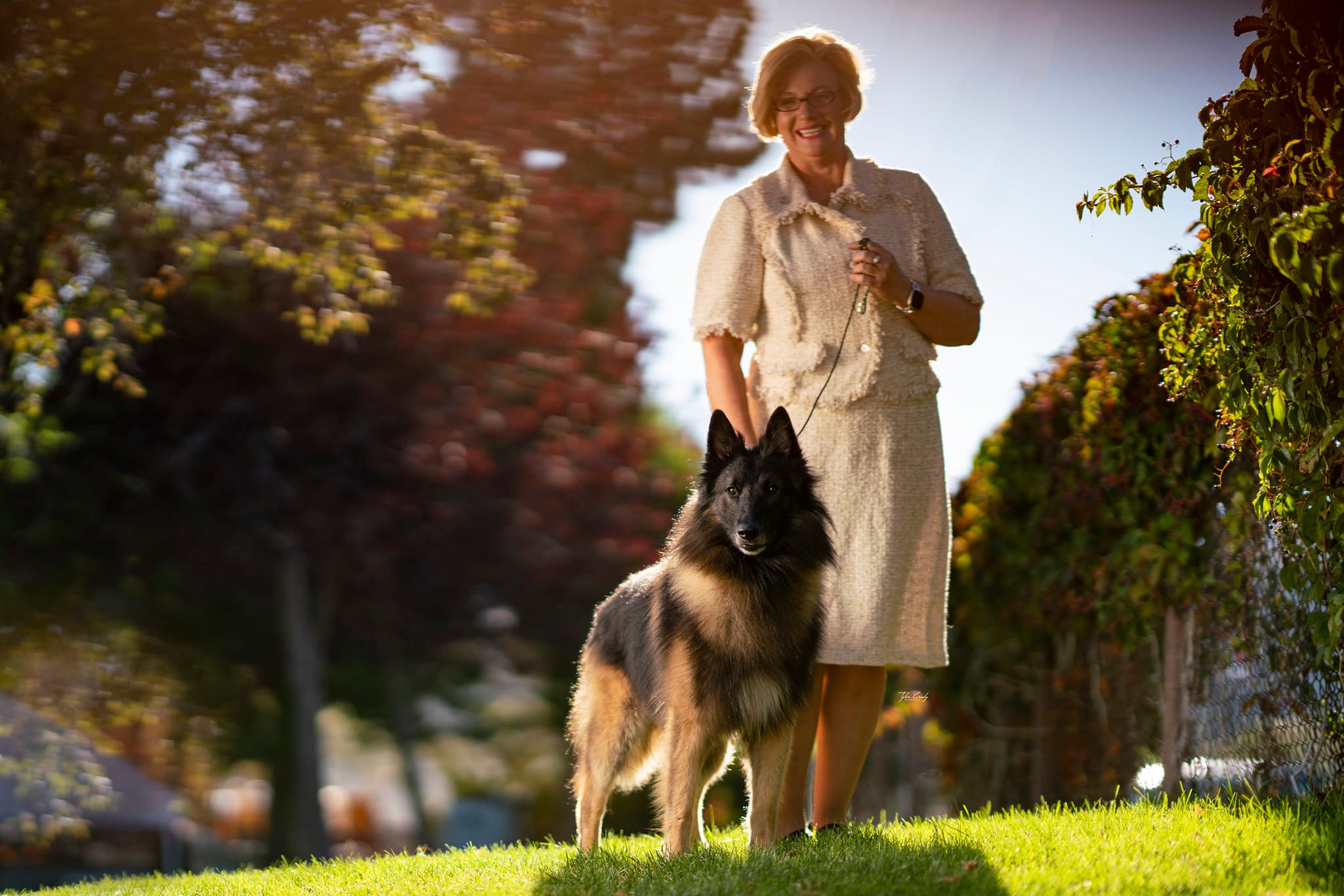
Karyn Cowdrey, BlackFyre Handling Services.
start of life in the ring. I shouldn’t have to hand them off to a total stranger.
Laura Reeves, host and moderator:
The concept (of BPUP) is that the American Kennel Club wants to support the novice handlers and that the simple presence of someone more capable than they are, whether they be a professional or a breeder or what have you, is unnerving. And I don’t know that that’s a great solution. I think we all learn by being challenged, but I know it is something that is a thing.
AKC gets banged a lot for not being encouraging and inviting and we as the representatives of the AKC get banged for the same thing. I sincerely believe that for people who think it is a big deal, they should get to do that. They should get to have that moment.
Hope is what gets us and keeps us. And I guess that’s what I would pin Best Puppy to. Is that baby inkling of hope. That tiny tingle of hope that the very new person gets when they get their first puppy.
And they are so excited and they don’t know what the hell they’re doing. And their breeder’s probably shoving them in the ring. And they’re really encouraging them to do this. It’s hope. And I guess to me, when I judge it, when I see it, best puppy to me represents hope. It represents the hope that we as breeders have for those puppies that are in the ring. It represents the hope that those owners and handlers have for their new puppies. It’s hope.
BPUP represents the hope that those owners and handlers have for their new puppies. It’s hope.
The part of me that thinks that hope is important, thinks that owner handled being what is important and encouraging new people being what’s important, I see the argument to make it a quote -unquote safe space from professionals.
Join us for the full replay of this spicy hot topic.
512 – No Best in Show? Looking Back with Bo Bengtson
No Best in Show? Looking Back with Bo Bengtson
Author, historian, editor and Sighthound specialist Bo Bengtson joins host Laura Reeves again for a fascinating look back at dog shows *before* Best in Show.
“You gotta go several thousand years back basically,” Bengtson said of people appreciating the beauty of dogs. “Even in the Odyssey, which is Homer 2,000 years ago, there is a reference that cited the people who own dogs because they’re handsome, because they look good.
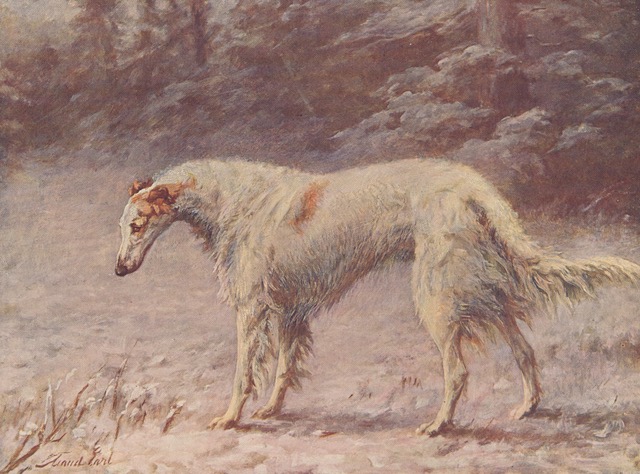
Sighthounds were a favorite subject of artists through the centuries, including this stunning Maude Earl Borzoi canvas.
“That’s kind of really interesting to me that even in those days people cared about what dogs look like. Going through the Middle Ages and forward, you find several references to not just hunting dogs or war dogs or something, but also to luxury dogs or pets. Greyhounds of all types are very, very frequently portrayed.
“And then we get up to the 1800s and middle of 1800s and the industrial revolution in England. Suddenly, there was a whole new class created by the industrial revolution. People who had money and had time on their hands and what could they better focus on than dogs. That was very interesting to them and that’s where the beginning of the modern dog sport really stands.
“The dog shows of the past were not at all like modern dog shows. There was often a best in show award but even defeated dogs could actually compete for it. There were no groups and there were not even necessarily breeds.
“In 1924, the American Kennel Club introduced new regulations and since then it’s basically been (the same). The number of groups has increased slightly and the number of breeds increased drastically, but their regulations for competing have remained unchanged.
“Even in my early days, in the 1980s in this country, there was not even necessarily Best in Show. I remember very, very vividly that I had a group winner who was not allowed to compete for Best in Show because there wasn’t a Best in Show at that show. In the beginning, only half the number of shows had the best in show award … eventually that grew up to present day.
“There have always been people who are nuts about competing for best in show and campaigning dogs. I mean you don’t think of people in the ‘30s or ‘40s or something that is campaigning dogs. But they were. There was that Pointer in 1860 or something from Wales, that was shown at least 60 times. How do they even get to the show? And he was shown overseas too. How do you even know where the shows were? It’s amazing.
“In the 1950s, there were certainly not flights available as today and there were far fewer shows and dogs still managed to win 20 or 30 best in shows per year. People were competitive even then.
“I think it’s a pretty rarified sport in many ways. I mean they make it fun sometimes and I think it’s fascinating. I think there’s nothing like sitting with a catalog and watching a bunch of dogs of the same breed being judged by an expert. That’s totally fascinating. But most people don’t think so. I think you need a special type of interest or mind or something like that. Maybe you have to just be a little weird.”
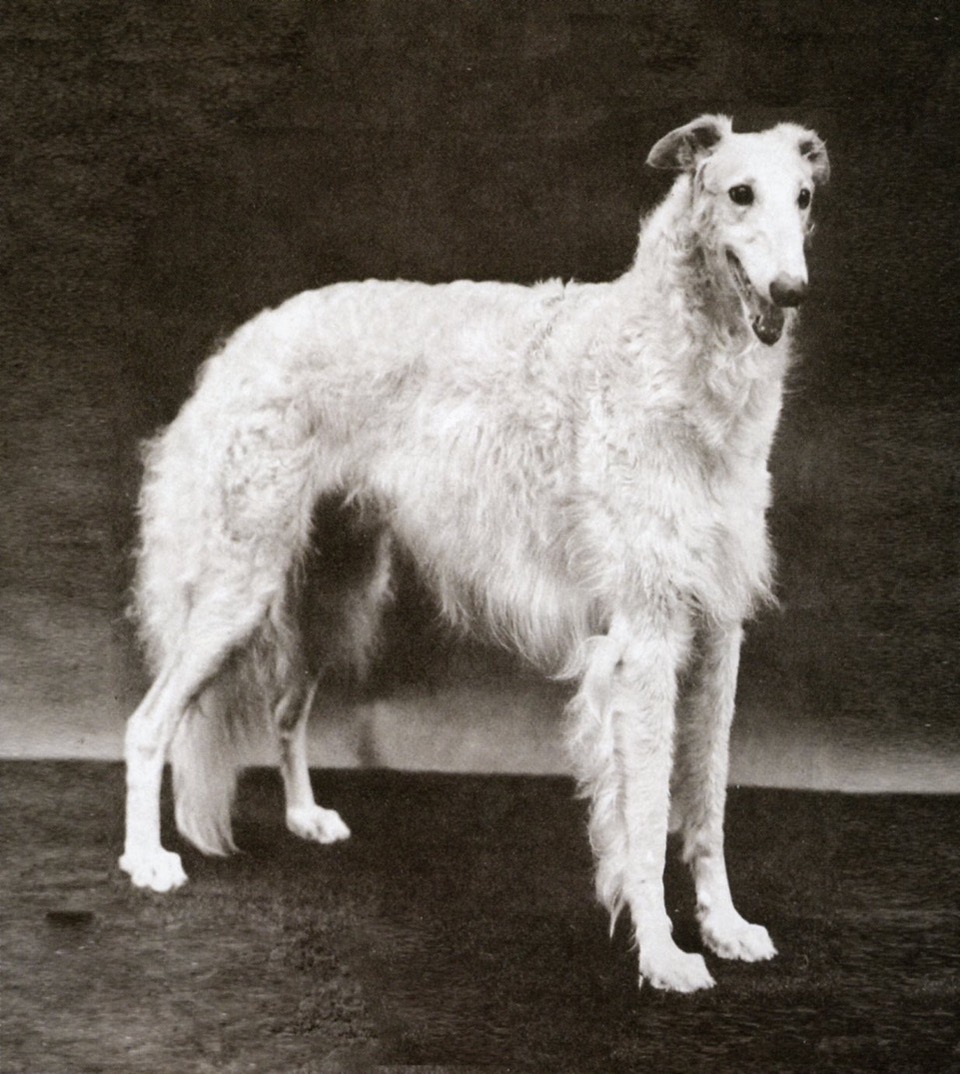
Spoiler alert, a photo of Bo’s hound group winner, in his dream BIS lineup, the great Borzoi Vigow…
Be sure to listen in to catch Bo’s incredible Best in Show lineup representing dogs of yesteryear through present times.
Purchase Bo’s encyclopedic and gorgeous book Best In Show here and visit his fascinating Facebook page of Great Show Dogs of the Past here.
434 – Bill McFadden on Dog Shows During Covid: Safety First
Bill McFadden on Dog Shows During COVID: Safety First and Other Observations
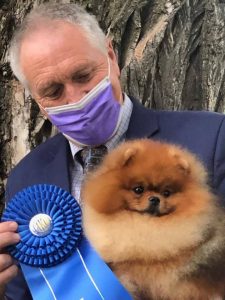 Professional handler Bill McFadden has attended shows across the country in the four months since the “Learning Cluster” in Oklahoma. A two-time Westminster Kennel Club BIS winning handler, lifetime participant in the sport and all-around good guy, McFadden’s observations, notes on what worked and self-appointed “bathroom police” stories provide a glimpse into this unprecedented time in American history.
Professional handler Bill McFadden has attended shows across the country in the four months since the “Learning Cluster” in Oklahoma. A two-time Westminster Kennel Club BIS winning handler, lifetime participant in the sport and all-around good guy, McFadden’s observations, notes on what worked and self-appointed “bathroom police” stories provide a glimpse into this unprecedented time in American history.
“My overview would be that I am proud of our community,” McFadden said. “I think that they’ve stepped up and either endured or participated in whatever protocol was established for each show. I hope it continues that way. I hope that we continue to be safe. I hope we get through this and maybe learn a few things about ourselves and our sport in the process.”
Host Laura Reeves commented that the silver lining of the year’s trying times is that we can “apply lessons from what we’re provided by the universe. You don’t get to pick (the circumstances) but you can pick how you respond to it.”
“Everybody just be safe and set your own limits for what you will or will not tolerate and stick to it,” McFadden added. “I actually have been impressed by people that step outside their comfort zone and say ‘you know, you’re standing too close.’ Some of the shows, the stewards actually will come up and say ‘could you guys spread out,’ ’cause we all kind of congregate during the groups. You kind of hang out while everybody else is being gone over. Old habits die hard. It wasn’t being defiant, it’s just you need someone to remind you.
“So, I’ve been really impressed by those actions by individuals and by clubs. Some of them do it in the most unbelievably gentle and kind way where you’re just like ‘oh gosh I’m so sorry’ … every once in a while there will be someone that’s a little snarky, but for the most part I think people have been doing a really good job.
“I will admit that I was nervous as I drove 24 hours to Oklahoma … I think everybody was. I know my assistant was. I was pleasantly surprised. Personally, I just thought that there might be a few resistant people that wouldn’t want to follow the rules that were set up. I was super impressed. I thought everybody complied. It’s definitely different showing with a mask on.
“…(P)articularly in the beginning, with the first few shows, we were just so happy to see each other. A lot of us hadn’t communicated so we weren’t really sure how our lives had gone and how are you surviving … initially I think there was a lot of that. I mean it was like going to a family reunion. We were just was so happy to see people … as it’s progressed, there’s people that we’ve seen several times, so it doesn’t feel like you’ve been away for so long.
“But I really think most people are just… we’re all in it together. We’re enduring it. We know we’re going to get through it and we’re helping each other out as much as we can. If there is one downfall, it’s really hard to control the social distancing after the show…”
Listen in as McFadden covers hotels, airplanes, COVID testing and more.
343 — Saturday Symposium – Preservation Breeding With Experts
Saturday Symposium – Preservation Breeding With Experts
Host and Moderator Laura Reeves is joined by breeders/judges Lesley Hiltz, Sid Marx and Karen Ericson at the Whidbey Island Kennel Club with a robust conversation about preservation breeding. This is part one. Part two, including audience participation, conversation and more idea generation will be posted next Monday.
Preservation of our breeds to save their place in history

Lesley Hiltz
“When you judge in Europe,” Hiltz noted, “the average exhibitor age is mid 30s. There are lots of families, often three generations together. It’s a family sport. But they also only have one show a month. If we had fewer shows we could see more support for the ones remaining.”
Marx observed that too often exhibitors haven’t even read the standard for their breed.
“People become captive to what’s winning. Breeding to what’s winning rather than what’s correct. We want to get as many new young exhibitors involved in the sport as we can. But they need to make an effort to find mentors and learn the history of their breed,” Marx said.

Sid Marx
Ericson encouraged folks to “Get our dogs out among the public.” Clubs need to do things besides dog shows, she added.
“To get a dog from a breeder, you might as well apply to be a CEO of a fortune 500 company,” Erickson said. “Trust people with your best, not your worst. Tell them you are trusting them with a piece of my heart and legacy.”
“Dog shows in Australia are less stressful and more fun,” Marx said. “Certainly more wine is drunk. It’s a party at their shows. It’s an event.”
Proactive policies

Karen Ericson
Some ideas from the panelists:
- Encourage altered dog competition
- Encourage anyone who shows a spark to come to the dog show. Stop what you’re doing and share with public. Share excitement about the show.
- Bring back dog shows that stop at the breed level. Rankings are hurting us. The average person isn’t at the dog show to fight for Group 1.
- Follow Austalia’s lead: “class in group awards.” So if your 6-9 puppy wins his class, he competes in 6-9 competition in group. People stay for group, talk to other people in other breeds. Gives a whole lot of other people the chance to win something in group.
To hear previous discussions on this topic, click here and here
331 – John Buddie part 2: Respect, Reverence and Romance
John Buddie part 2: Respect, Reverence and Romance
Master Breeder, John Buddie, Tartanside Collies, talks about the three “Rs”: Respect of the individuals who went before, reverence of finding and holding these people in high regard, and the romance of the history and studying the lore of the breed.
“If it’s all statistics and numbers and cut and dried, I think you burn out,” Buddie said.
In the second half of our interview, Buddie talks about maintaining virtues, the importance of selection and having heroes.
“You can lose the existing quality in a line by not maintaining emphasis on virtues, especially when you are trying to achieve improvement in an outcross,” Buddie said. “Don’t put so much emphasis on that new added characteristic that you lose sight of what you’ve worked so hard on to date”
Outcrosses
“You don’t always get the results you were aiming for until the generation after what you’ve done. The key is what you do with the outcrossed generation that makes or breaks you.”
Selection, selection, selection
- Take time to really observe and evaluate puppies at various ages.
- Don’t get rid of a puppy too early or too late.
- Good, but not good enough. Is it the best of the best or the best of what you have?
- Make a list of virtues of sire/dam… Identify what you most want to keep a puppy for from the litter.
- Watch puppies in a pen. Too many folks want to just pick up and look at profile.
- I take my time when evaluating puppies. People rush to judgement.
- Photos give you a static picture and can be inaccurate based on how legs are placed.
- More important to see in a natural position.
Back in the day, the optimum time to finish a dog was three years old, Buddie noted.
“I’m afraid too many people are just getting the points, not really appreciating the dog show itself, the evaluation process, who you showed to and what a difference it made.
“Be stimulated by being inspired. Just make sure you’re inspired by the right person who really believes in the sanctity of the breed and the sport,” Buddie said.
Listen to Part 1 of our conversation here.
296 – Pat Trotter, Dorothy Macdonald and Kim Meredith Speak at Forum
Pat Trotter, Dorothy Macdonald and Kim Meredith Speak at Forum
Today’s episode is part one of a Pure Dog Talk Friday Night Forum at Del Monte Kennel Club in 2017. The panel features Pat Trotter, Dorothy Macdonald and Kim Meredith addressing the topic of the “Judge-Exhibitor Relationship.” Learn about the background and priorities of these legends in the sport.
This Forum was originally available as a livestream video. We’re now bringing everyone all of the information in a three-part series on the podcast.
Topics in this section of the forum include background of the judges, what the judges want to see in the ring, how to ask judges about a dog, the judges’ opinions of the National Owner Handled Series and withholding ribbons.
Learn From the Source
In a current moment that features social media commentary pages on which exhibitors “report” on the judges, often with great vitriol, the value of hearing directly from the judges and what matters to them cannot be overstated.
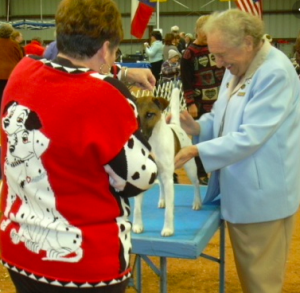 A highlight of the conversation is Dorothy Macdonald’s description of coming to the US with her family in 1941 and bringing the dogs they could with them, including a Kerry Blue Terrier rescued from Dunkirk.
A highlight of the conversation is Dorothy Macdonald’s description of coming to the US with her family in 1941 and bringing the dogs they could with them, including a Kerry Blue Terrier rescued from Dunkirk.
Macdonald is noted as one of a handful of judges who judge both conformation and field trials.
“I judged field trials as many years as dog shows,” Macdonald said. “I put up the first English setter running in the field that was a show champion.”
“As long as you’re more interested in the dogs than the people, there will never be a split (between exhibitors and judges),” Macdonald said. “I want an exhibitor to be happy in the ring. I’m interested in the dog, not the exhibitor’s ability. Just need them to control the dog. It’s the dog I want to see.”
“We all had a first time in the ring,” Trotter said. “I do want them to have a dog that’s somewhat prepared for the event. I want to have a dog we can go through the process … see the bite, see the dog move.”
“I’m always happy to talk about the dogs I’ve judged,” Meredith said. “Attitude and how the question is approached are everything.”

